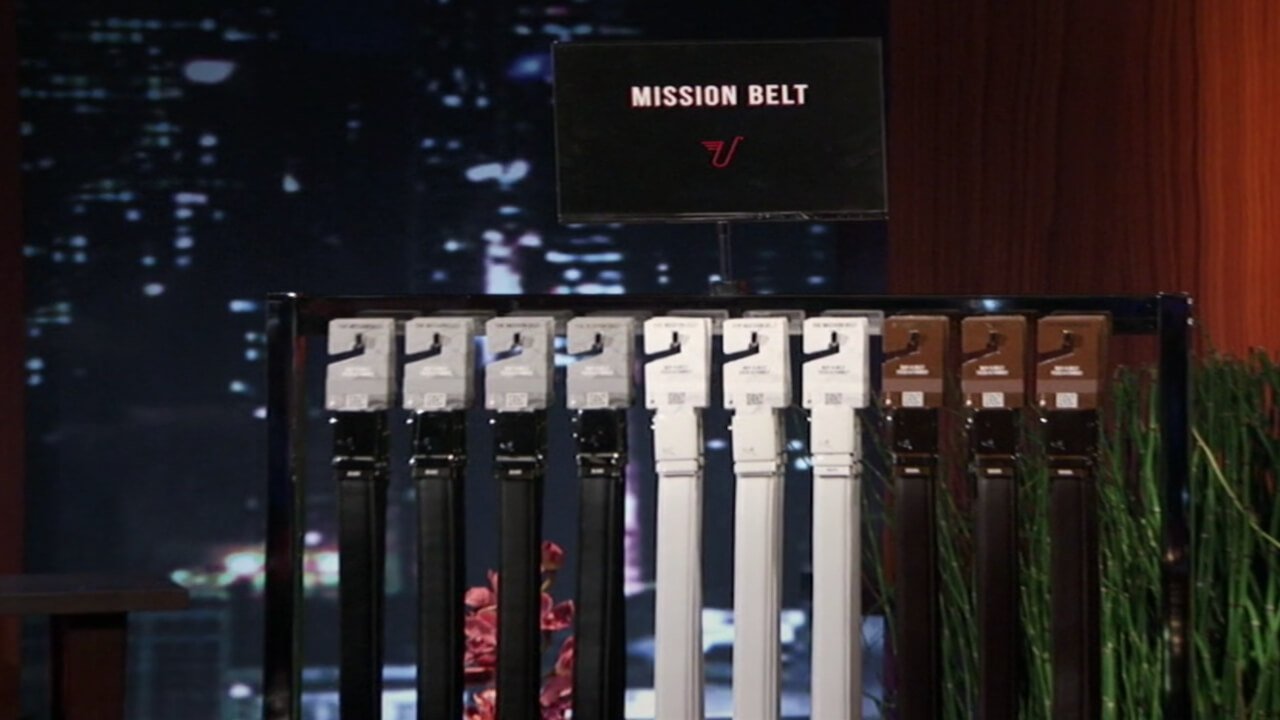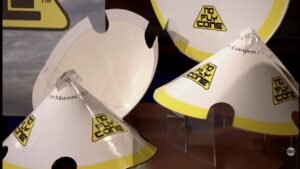They got a deal… but did it really matter? That’s the question every Shark Tank fan should ask about Mission Belt. Because not every handshake on stage leads to a happy ending—or even a profitable company a year later. Yet, years after its TV debut, entrepreneurs still talk about Mission Belt’s pitch, its numbers, and that infamous founder soap opera. Want to know why? Grab a coffee. Let’s get street-level honest about what happened on Shark Tank, who’s still pocketing the profits, and what every hustler can learn from this no-holes brand.
Why Mission Belt’s Shark Tank Pitch Still Gets Talked About
Mission Belt hit the tank in Season 4, Episode 22—one of those classic episodes fans still binge for drama and inspiration. Nathan Holzapfel, the face of Mission Belt, strolled in with more swagger than most. He pitched a simple promise: a better belt, built to last, with a cause behind it. No holes, no more ugly stretched-out leather, and a loosening system you could adjust after a big lunch.
But the real sizzle was the pitch room tension. Ask any Shark Tank junkie, and they’ll tell you—some pitches just punch above their weight. This was one of them. The Sharks bit hard. The crowd at home? They remembered the company name. That’s not luck. That’s branding done right, right from the start.
The Idea Behind Mission Belt: Simplicity With an Edge
Let’s talk product, because this wasn’t just one more belt. Holzapfel and his crew ditched the traditional belt holes that always tear and stretch. Instead, they built Mission Belt around a ratchet-style mechanism—click-to-fit, automatic, fast, and genuinely more comfortable than your regular old strap.
Here’s what made it pop:
- No holes. No mid-day wardrobe malfunctions.
- Sleek design. The kind of belt you could gift for Father’s Day and not regret later.
- Durability. Real materials. Not a fast fashion throwaway.
- Most belts die in months. Mission Belt’s ratchet lasts years.
But there was an X-factor many forget: charity. For every belt sold, the company funded microloans, betting on stories bigger than just making fat profits. Holzapfel said if they were going to sell something basic, it had to do good too.
That wasn’t just window dressing; it gave the company a marketing edge and story for press, social, and—yep—the Sharks.
Pitch Room Play-by-Play: Deal or No Deal?
Let’s break down the pitch. Holzapfel came in asking for $50,000 for 20% equity. Classic fair ask if you’ve got big margins, but also enough skin for a Shark to care. Most founders blow it in the room with wishful numbers, but Nathan stuck to the script, oozing confidence.
Here’s how it played out:
- The Sharks start circling—war stories, prodding the margins, asking about manufacturing.
- The product looked sharp. The pitch? Even sharper.
- Mark Cuban gave a classic Don’t be greedy, take the deal nudge—not as a player, but as an advisor to Nathan.
- Daymond John, king of retail, bit the hardest. He offered $50,000 for 37.5%. More chunk than Nathan wanted to give, but the value Daymond brings on licensing and scale? Priceless.
Nathan didn’t overplay his hand. I’ve seen founders torpedo deals by haggling over 2%. He shook on Daymond’s offer. Sometimes you give up more; sometimes you get more than money. (Here, Daymond promised to run licensing and manufacturing. Nathan was told: you’re steering sales.) Pure Shark Worth logic.

Net Worth and Sales Numbers: How Big Did This Get?
Let’s cut to the money. Here’s what Mission Belt pulled post-show:
- $180,000 in sales the night of their episode airing. Not bad for a single day’s TV time.
- $1,000,000+ in the first month after Shark Tank. That’s real velocity—no smoke and mirrors.
- Projected $5,000,000+ in the first year. These aren’t wishful after a few years numbers. This happened quickly.
Want to know if Shark Tank makes a difference? Look here. That’s the power of credible pitch, a clean story, and a product that actually solves a pain point. Was this company ever going to be a billion-dollar unicorn? Probably not. But for a physical product with tight margins, that’s big, real growth.
And don’t forget: much of this traction powered their charity angle too. Each sale = good PR + feel-good factor.
Founder Faces and Fallout: Who Ran the Show, Who Got Booted?
Nathan Holzapfel was the Mission Belt face on TV. But behind the scenes, there were other co-founders, less flashy but no less important. (Pro tip: The loudest founder isn’t always the only one making moves.)
But the story takes a dark turn. Nathan saw the cash, saw the limelight, and soon brought legal headaches you wouldn’t wish on your competition. Two big ones:
- 2019: Holzapfel loses a lawsuit to Larry King. Bad headlines.
- 2021: Bigger trouble. Nathan is arrested on fraud charges, plus more accusations coming later.
By this point, the company knew it had to act. Nathan was out. The partners did what every healthy startup does when a founder becomes a liability—they cut fast and moved forward.
Most companies crumble with this kind of PR nightmare. Not Mission Belt. The team kept things rolling, sharpened their brand, and put the problems in the rearview.

Charity Betting on Microloans: Feel-Good or Just Good Marketing?
Was the charity angle just for good press, or was it a smart play all along? Let’s get real—every company leans into what sells. For Mission Belt, the microloan program with Kiva.com was both a genuine mission and a killer sales angle.
Picture this: every belt you buy helps fund an entrepreneur somewhere who’s scrapping their way out of poverty. That doesn’t just sell products—it creates fanatics. Repeat buyers buy the story as much as the belt.
But here’s a hard truth: good intentions don’t move stock without good business sense. They pulled a Bombas move—purpose-driven, but tight on execution, which is why the numbers kept climbing.
Is Mission Belt Still in the Game?
Fast forward to today: Mission Belt is still alive and selling strong. They shook off their founder drama, refocused the team, and kept shipping product. The microloan initiative is still featured front and center.
They didn’t branch into a wild catalog. They stayed obsessive about belts—and it worked. Sometimes you don’t need a dozen new products; you just need to dominate your category. It’s Scrub Daddy energy: one flagship product, endless demand, and relentless DTC hustle.
Who’s running the show now? The founders who didn’t make TV, plus a team that knows how to keep vision and scandal apart.
They weathered the PR storm, kept the website humming, and prioritized customer trust. Mission Belt isn’t some forgotten gimmick collecting dust. It’s a go-to gift and self-upgrade for guys who want better gear.
The Real Story: What Entrepreneurs Can Learn from Mission Belt
Here’s what you should steal from this story if you run—or dream of running—a business:
- Strong branding matters. You can sell a belt or you can sell a mission. The second one wins hearts and wallets.
- Take the right deal, not just any deal. Nathan didn’t get stubborn—he gave up more but got Daymond’s infrastructure. That’s smart, not desperate.
- Don’t tie your whole brand to one face. Founders are great for PR until they’re not. Have a plan for what happens if the spotlight turns toxic.
- Momentum is everything. Shark Tank gave them rocket fuel, but it’s what they did next—grinding every day, fixing problems, sticking to their story—that paid the bills.
- Scandal-proof your business. When Nathan imploded, Mission Belt survived. That’s not luck—that’s real company culture.
If you want your business to outlive your mistakes, look at these moves. The Mission Belt team did the hard, unglamorous work. That’s where real wealth—real Shark Worth—is built.
Wrap Up: Mission Belt’s Shark Tank Legacy
So, is Mission Belt a Shark Tank legend, or a cautionary tale? It’s both. If you just want a feel-good underdog story, you’ll find it. If you want to know what tough founders do when things go sideways, read between the lines.
They scaled fast, weathered ugly founder drama, kept their promise to a cause, and didn’t let one man’s mistakes sink the ship. Not all deals on national TV work out this clean. Mission Belt proves that if your product solves a real problem, and your team is sharp, you can take the investor shockwaves and still win.
Want to see what Shark Worth looks like in real life? Watch the replays—but follow the money after the cameras stop rolling. That’s where the real hustle starts.
FAQs for the Curious (and the Cynical):
1. Is Mission Belt still in business since Shark Tank?
Yes, Mission Belt is still in business and selling strong online. It survived founder drama and is going nowhere.
2. Did Daymond John really help the company after the show?
Yes. Daymond brought connections, licensing know-how, and scale. That’s why the deal was worth the bigger chunk he took.
3. How much money has Mission Belt donated to charity?
Details change, but they’ve funded thousands of microloans with Kiva.com. Their charity track is real, not just PR talk.
4. What happened to Nathan Holzapfel after Shark Tank?
Nathan got ousted after legal and personal scandals. He’s no longer connected to Mission Belt at all.
5. Where can I buy Mission Belt products now?
Direct on their website, online retailers, or Amazon. The company owns its DTC channel now—classic Shark Worth playbook.
6. Did Mission Belt add new products or stick to belts?
Mostly stuck to belts. They doubled down on perfecting the core product rather than diluting focus.
7. How much is Mission Belt worth now?
No open net worth, but based on sales—multi-millions in value. Still profitable and still growing.
8. How did the Shark Tank deal change the company’s direction?
Daymond’s deal brought credibility and reach, helping Mission Belt scale beyond just TV flash. The business got sharper after the founder split.
For more deep Shark Tank breakdowns, numbers, and real stories behind the TV pitch, check out SharkWorth. Because the grind does not end when the credits roll.










